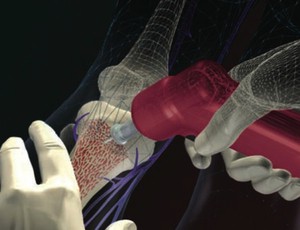Intraosseous access device comparison – Full Text

“We sought to compare the efficacy and safety of the NIO to an established, well-studied device, the EZIO, when used for resuscitative vascular access in the emergency department” Drumheller et al (2022).
Intraosseous infusion technique explained

“The intraosseous infusion procedure is easy and the learning curve is short, making it the best alternative when traditional intravenous access is not possible or delayed” Meynet et al (2022).
Intraosseous access associated fat embolism – Full Text

“The results of our study seem to confirm that IIC can lead to PFE in a pediatric population and show that the PFE after IIC can be important (up to score 2 of Falzi)” Castiglioni et al (2022).
Intraosseous access in pediatrics

“Successful prehospital IO access was achieved in 83.7% of patients. The median time required to achieve IO access was 4 minutes (IQR 3-7) and mean duration of IO function was 27.6 minutes (SD: 14.8)” Garabon et al (2022).
Intraosseous needle placement – Full Text

“Intraosseous (IO) access is critical in resuscitation, providing rapid access when peripheral vascular attempts fail. Unfortunately, misplacement commonly occurs, leading to possible fluid extravasation and tissue necrosis” Kyle et al (2022).
Powered intraosseous access systems – Full Text

“This study demonstrates that emergency physicians prefer and value a novel IO system with features that enhance safety and ease of use” Little et al (2022).
Vascular access in low-light conditions

“The optimal tactical lighting for performing medical procedures under low-light conditions is unclear” Iteen et al (2022).
Intraosseous catheterization training

“The results of the testing have shown the need for periodic intraosseous catheterization training so that physicians who have not practiced this manipulation would not lose the relevant skills and perform this manipulation safely when needed” Kikodze et al (2022).
Emergency vascular access device placement in Australia

“Queensland paramedic practices relating to insertion of PIVCs, and IO devices appears consistent with documented practice internationally” Mason et al (2022).
3D printed intraosseous infusion simulator

“The goal of this technical report is to describe the development and evaluation of a three-dimensional (3D)-printed Pediatric IO Infusion Model for simulation-based medical education” Wade et al (2022).
Timely access to intraosseous access devices – Full Text

“Task-based package organization of neonatal emergency backpacks is feasible and might be superior to ABC-/material-oriented storage” Sommer et al (2021).
Ideal intraosseous insertion site in neonates

“Therefore, the aim of this study was to determine the ideal intraosseous insertion site distal to the epiphyseal growth plate in neonates” van Tonder et al (2021).
Intraosseous or intravenous epinephrine administration

“These findings support the inclusion of intraosseous access as a route for epinephrine administration in current guidelines” Roberts et al (2021).
Intraosseous access complications

“Our review identified a complication rate of 2.7%, with complications including compartment syndrome, needle breakage, and a previously unreported cutaneous complication of traumatic bullae” Konopka et al (2021).
Intraosseous vascular access device comparison

“Each of these devices provides an effective route for fluid resuscitation, drug delivery, laboratory evaluation, and shortening the timeframe for established vascular access, provided that the person obtaining the access is acquainted with the use of the device” Drozd et al (2021).
Tibial intraosseous drug administration

“Our aim was to determine whether prehospital administration of resuscitative medications via the IO route was associated with lower rates of return of spontaneous circulation (ROSC) and survival to hospital discharge than peripheral intravenous (IV) infusion in the setting of OHCA” Hamam et al (2021).
Intraosseous valproic acid administration – Full Text

“IO-delivered VPA is noninferior to intravenous administration and is a viable option in emergent situations when intravenous access is unattainable” Biesterveld et al (2021).
Double site intraosseous blood transfusion

“Dual anatomic site, pressure bag driven, intraosseous blood transfusion approximately doubles flow rates without evidence of clinical complications or hemolysis” Sulava et al (2021).
Complications of intraosseous access

“Intraosseous (IO) access is an effective surrogate for intravascular access in critically ill patients. We present 2 cases of IO complications” Arakawa et al (2021).
Intraosseous access in newborns consideration of alternative sites

“Proximal humeral head and distal femoral end might be alternative IO areas which may lead to further IO puncture sites in neonates” Eifinger et al (2021).
Intraosseous thrombolysis following PE and cardiac arrest – Full Text

“This case demonstrates successful thrombolysis through an intraosseous route, with a good outcome despite poor prognostic factors” Nweze et al (2020).
Intraosseous administration of hydroxocobalamin for cyanide poisoning

“This appears to be only the second reported human case of intraosseous hydroxocobalamin administration” Mastenbrook et al (2021).
Comparison of intraosseous access and central venous catheterization

“IO access is a safe, rapid, and effective technique for gaining vascular access in critically ill adults with inaccessible peripheral veins in the emergency departments” Liu et al (2021).
Intraosseous versus IV access during cardiopulmonary resuscitation – Full Text

“The meta-analysis revealed no significant association between types of vascular access and neurological outcomes at hospital discharge among OHCA patients” Hsieh et al (2021).
Intraosseous vascular access maintained for up to 48 hours

“This is the first known study examining the safety of IO access over a 48-h dwell time” Philbeck et al (2021).
Intraosseous route For thrombolysing acute stroke patients

“IO is an established method of obtaining vascular access in children and adults in acute emergency situations. It can be used for effective thrombolysis in acute stroke patients” Banerjee et al (2021).
3D-printed model for simulation training in intraosseous access – Full Text

“Residents and emergency medicine physicians practising in rural Newfoundland and Labrador found the 3D-printed trainer to be a practical tool for practising intraosseous technique” Engelbrecht et al (2021).
Intraosseous contrast administration for emergency stroke CT

“We present the first case of IO contrast administration for CT imaging in suspected acute stroke” Krähling et al (2021).
Intraosseous or peripheral IV access in pediatric cardiac arrest?

“The aim of this study was to assess the impact of the intravascular injection route on the return on spontaneous circulation” Recher et al (2021).
Vascular access outcomes while wearing PPE – Full Text

“This comprehensive meta-analysis suggests that the use of PPE significantly extends the duration of intravascular procedures” Drozd et al (2021).

